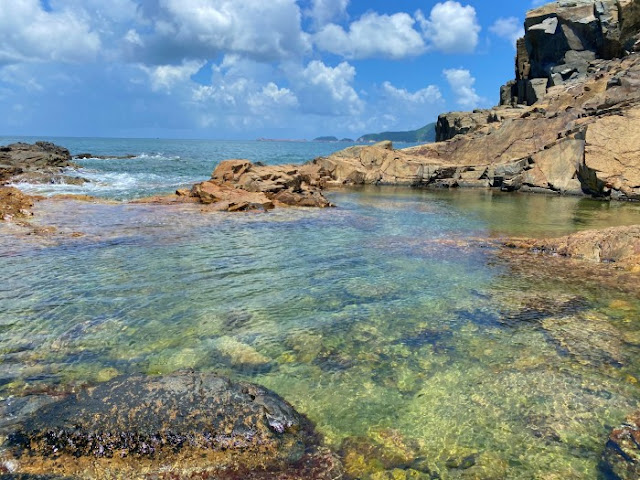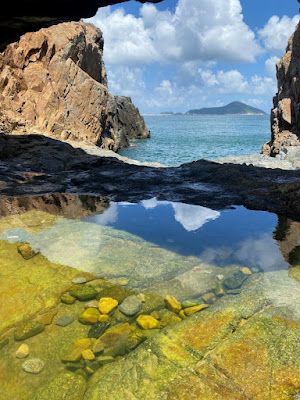Cape D'Aguilar 鶴咀
My best friend and I visited Cape D’Aguilar / Hok Tsui 鶴咀on a weekday in June. I heard about the place a few times and was stunned when I was there in person. It is not like a place in Hong Kong, but a rough coast somewhere in the world.
Cape D’Aguilar is a peninsula south of Shek O, on the southeast side of the Hong Kong Island. The coastal trail is easy. It leads to some of the most beautiful and breathtaking spots. Spectacular caves, rock formations, a lighthouse and marine reserve will delight you for sure. The day trip was incredible.
Cape D’Aguilar can be easily reached by Bus 9 departing from Shau Kei Wan, served by underground. The normal bus route passes Cape D’Aguilar. But some buses skip it. Be sure that you will get on the right one.
Once
you have got off the bus, simply walk down along Cape D’Aguilar Road. It is a
paved street with some traffic. So, beware of it and keep safe. Along the path,
one can see the scenic coastal views of Stanley / Tai Tam and the South China
Sea. At our time, in June, we were
sweating a lot along the path but once we are at the Cape, the breeze and
magnificent views cooled us down.
The marine reserve is one of the six marine parks and reserves in Hong Kong. Divers were seen going out of the sea from time to time. They were lucky to see the natural biodiversity of fish and coral. We, on the land, were fascinated with the rock formation.
The first one welcomed us is the Thunder Cave. It is a narrow opening between the rocks that opens up to the sea on the other side. The echoing sounds of waves crashing against the rock mimic the sound of rumbling thunder in the distance.
It is a bit dark inside. The narrow opening leading to the sea is both mysterious and hopeful, like the light at the end of a tunnel. Fierce waves can crash and gush into the cave. So, be careful!
From the Thunder Cave, walk back up to the main path and continue walking down the slope. You will see the display of a whale’s skeleton. It belonged to an infant fin whale (Miss Willy) that perished along a pier in Victoria Harbour in April of 1955. Most likely the baby whale got separated from its mother during their migration northward. It starved without the milk from its mother.
The whale bones were cleaned, dried, and displayed at HKU. In 1990 when Professor Brian Morton founded the Swire Marine Laboratory (now SWIMS) the skeleton was erected onto a metal frame and secured to the rocks overlooking the bay at Cape D’Aguilar.
Nearby is the most famous spot of Cape D’Aguilar, the Crab Cave. Just traverse a few rocks to reach it. At the centre is a square-shaped hole that one can see out to the ocean.
If on a cloudy day, the waves can be rough with storming tides. At our visit, on a sunny day, the cave’s surrounding is serene. Beautiful colours at the small pool in front of the Crab Cave entrance left us unforgettable fond memories. One can also climb the top of the Crab Cave for epic views of the islands floating on the sea.
As we visited Cape D’Aguilar on a weekday, the area was almost empty. We could relax at a shady costal spot to enjoy the sweeping sea views and our packed lunch. The ocean shimmered and enters the eye with varying shades of blue. Waves crashed on the craggy coast. What a beautiful and serene atmosphere! We didn’t feel we are in but out of Hong Kong.
On the way back, at the next fork in the road, you can opt to visit the lighthouse. At the end of the road there’ll be a little set of stairs right beside the locked gate. Climb up it and you’ll be at the foot of the lighthouse.
The lighthouse was put into service on the 16th of April 1875. Its light beam could be seen from up to 23 nautical miles away!
If
you wish to have a superb view of the lighthouse, head back to the Radio
Station before you reach the Marine Reserve. Take the flat path marked by a
blue ‘300m’ sign and continue until you see a set of stairs. Go up for the
wonderful views of the lighthouse and the Bokhara Battery in the distance. As it was very hot, we skipped it and headed
back to Shau Kei Wan for afternoon tea.


















Comments